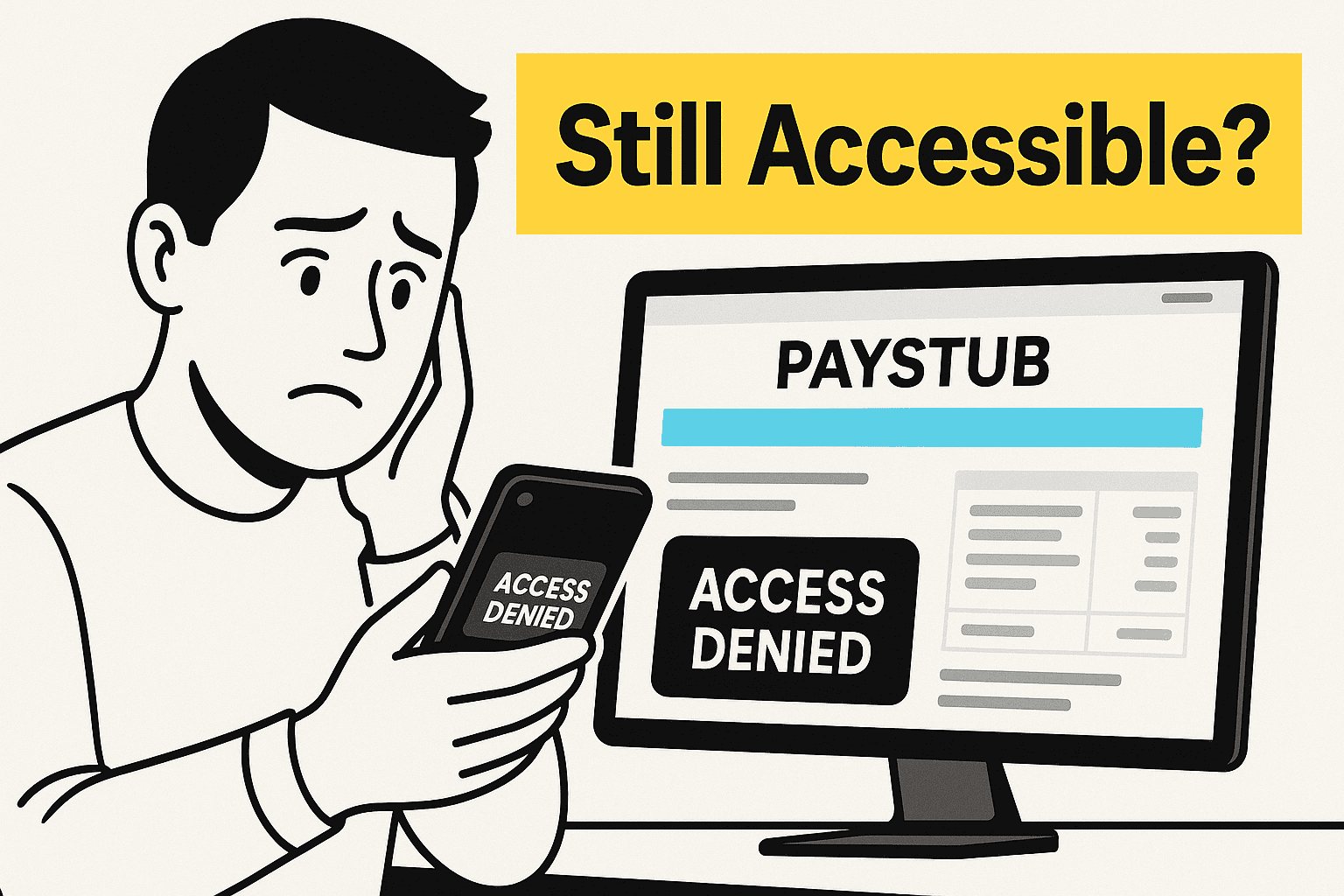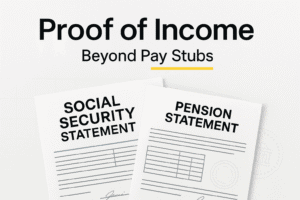Introduction
Last updated: August 2025 • By the FinancialDocsProvider Editorial Team
If you’ve left a job and suddenly need proof of income, it’s natural to ask how to view paystubs online after termination. Access often depends on your former employer’s payroll platform and how long they keep ex‑employee portals active. Even when you can’t log in anymore, you still have options to retrieve your historical wage statements and tax slips lawfully.
At FinancialDocsProvider.com, we specialize in proof of income editing and packaging that improves readability and presentation—never changing the facts. When lenders, landlords, or verification services ask for clean, consistent files, we can help you format what you already have, bundle supporting pages, and export to the right file types.
- Related Entities & Terms
- Paystub / Payslip / Wage statement
- W‑2, 1099‑NEC (US)
- P45, P60 (UK)
- T4, Notice of Assessment (NOA) (Canada)
- Direct deposit & payroll deduction summaries
- Payroll providers: ADP, Paychex, Workday, Ceridian Dayforce, Sage, Xero
- Regulators: IRS, CFPB, FTC (US); FCA & GOV.UK (UK); CRA & FCAC (Canada)
- Employment records & recordkeeping
- Income verification & underwriting
- Bank statement cross‑checks
- Data privacy & redaction
- Document reconciliation & audit trail

Below, we explain what employers typically maintain, what you can request, and how to present records cleanly without altering facts. You’ll find region‑specific notes for the US, UK, and Canada, plus checklists, red flags to avoid, and official resources.
Law Basics: Can you view paystubs online after termination?
Short answer: sometimes. It depends on your ex‑employer’s portal policies, local labor rules, and how long records are retained. Even if portal access ends, you can usually request copies from payroll or HR, and you’ll still receive or be able to obtain the relevant tax forms for year‑end reporting.
US overview
In the United States, the Fair Labor Standards Act (FLSA) requires employers to keep certain payroll records. However, there’s no single nationwide rule that forces employers to provide pay stubs or maintain ex‑employee portal access. Many states do require itemized wage statements and set retention periods. If your online access was shut off, you can still request copies via HR or payroll. Year‑end forms—such as the W‑2 for employees or 1099‑NEC for independent contractors—must be provided, typically by the end of January for the prior tax year.
Helpful official references:
- U.S. Department of Labor, Wage and Hour Division (recordkeeping and worker rights)
- IRS Get Transcript (for wage & income transcripts)
- IRS Form 4852 (Substitute for Form W‑2 if you cannot obtain a W‑2)
UK overview
In the UK, employers must provide itemised payslips to workers on or before payday. After employment ends, online access to payroll portals may be withdrawn. You can still request copies and should expect to receive a P45 when you leave and a P60 after the tax year ends if you worked for the employer that year. HMRC guidance and GOV.UK resources are good starting points for rights and processes.
- GOV.UK: Payslips
- GOV.UK: PAYE forms (P45, P60, P11D)
- Financial Conduct Authority (FCA): Consumer support
Canada overview
In Canada, employers generally must provide pay statements. Access through an ex‑employee portal can end after termination, but you may request copies. For taxes, a T4 slip is issued for employment income, and you can often view tax slips via CRA’s online services. For financial‑consumer guidance, FCAC maintains helpful educational resources.
- CRA: My Account (access tax slips like T4)
- Financial Consumer Agency of Canada (FCAC)
Bottom line: Whether or not you can still log in, you can usually retrieve lawful copies—via HR, payroll providers, or government tax portals. Save copies as soon as possible after your final payday to avoid last‑minute scrambles.
What Edits Are Allowed (Formatting, Redaction & Exports)
When sharing income proof with a lender, landlord, or letting agent, presentation matters. Formatting is often necessary and lawful. Altering facts is not.
Redaction for privacy
- Mask partial account numbers or employee IDs.
- Redact sensitive items such as national insurance/SIN/SSN except last 4 digits, if requested.
- Hide non‑relevant benefits codes while keeping gross, net, taxes, and deductions visible.
Readability improvements
- Combine multi‑page paystubs into one PDF with bookmarks.
- Fix skewed scans, rotate pages, correct contrast, and add OCR for search.
- Standardize file names and date labels (e.g.,
2025‑05‑31_Payslip_ABC‑Ltd.pdf).
Export & packaging
- Export embedded attachments (like year‑to‑date summaries) from payroll portals.
- Create a packet that includes bank deposit screenshots for cross‑validation.
- Bundle W‑2/P60/T4 pages with corresponding payslips for the same period.
What’s Illegal (and the Consequences)
Altering facts on a paystub, payslip, bank statement, or tax form can constitute fraud. This includes changing amounts, dates, employer details, or hours worked. Even “small fixes” are prohibited. Many institutions verify documents directly with payroll providers, tax authorities, or through income‑verification services; discrepancies can trigger denial and reporting.
Potential consequences include application rejections, account closures, loss of tenancy, and—where laws apply—fines or criminal charges. Institutions maintain internal blacklists and share fraud intelligence. Assume your packet will be audited and keep an impeccable trail of originals.
Common Use‑Cases & Practical Scenarios
Whether you’re a renter, applying for an auto loan, refinancing, or compiling an immigration dossier, here’s how ex‑employee access typically plays out and what to do next.
Scenario: You’re a renter applying for a flat/apartment
Problem: The letting agent asks for your last three payslips. Your former employer disabled portal access the day you left.
Solution path:
- Email HR or payroll with a concise request (include full name, former employee ID if known, NI/SIN/SSN last four, dates of employment, and the exact pay periods needed). Ask for PDFs or sealed copies.
- Search your email for “payslip” or “pay statement”—many systems send a monthly PDF or secure link.
- Check bank statements for matching deposits. Use selective screenshots as supporting evidence.
- Package the retrieved payslips with a brief cover note that maps deposit dates to payslip dates.
- Use our bank statement formatting service to tidy supporting pages.
Scenario: Auto loan asks for “proof of income”
If you changed jobs recently, the lender may accept your new offer letter plus the final payslips from your prior job. If the portal is locked, request copies from HR and add an employment‑verification letter on company letterhead that confirms end date and position. Include W‑2/T4/P60 as available for year‑to‑date context.
Scenario: SBA or startup financing
Government‑backed lending typically requires tighter audit trails. Expect to provide year‑end forms, a sequence of payslips, and bank statements with redactions limited to personal info. Add a table of contents and bookmarks so reviewers can navigate quickly. We can help package the set without altering any facts.
W‑2/PAYE vs. self‑employed packets
- Employees (US W‑2 / UK PAYE / CA T4): Payslips + year‑end form + bank deposit evidence. Add employment letter if recent change.
- Self‑employed (US 1099 / UK self‑assessment / CA T2125): Invoices, contracts, bank statements, and tax transcripts. Include NOA (Canada) or HMRC/IRS summaries where relevant.
How We Work: Intake → Reconciliation → Formatting → Delivery
Our role is to help you present accurate records clearly and professionally. Here’s our typical workflow:
1) Intake
- We gather your originals: payslips/paystubs, year‑end tax forms, and optional bank proof.
- We confirm the purpose (rental, lending, immigration) and any formatting rules or submission portals.
- We outline scope, pricing, and turnaround.
2) Reconciliation
- We check that dates, pay periods, gross/net, and deposits align across documents.
- We note any missing periods and advise how to request them from HR or a payroll provider.
- We maintain a simple audit log so you can show your document trail.
3) Formatting
- We apply readability improvements, privacy redaction, OCR, and file naming conventions.
- We add a cover page with a contents list and optional cross‑walk from payslips to deposits.
- We do not change factual amounts, dates, or employers—ever.
4) Delivery
- We provide a single, clean PDF packet with bookmarks and logical order.
- If requested, we split the packet to match portal upload limits.
- We supply a brief “source list” summarizing where each document came from.
Want to know more? Read about our process or contact our team.
Quick Compliance Checklist
- Try the portal first. If you still have ex‑employee access, download everything: last 6–12 months of payslips and any year‑to‑date summaries.
- Request from HR/payroll. Provide full name, former ID (if known), last 4 of NI/SIN/SSN, date range, and format (PDF).
- Retrieve year‑end forms. US: W‑2/1099; UK: P45/P60; CA: T4. Use government portals when needed.
- Cross‑validate with bank records. Capture deposits that match payslip net pay. Redact non‑relevant transactions.
- Do not alter facts. No changes to amounts, dates, or parties.
- Name files consistently.
YYYY‑MM_Payslip_Employer.pdf,2024_W‑2_Employer.pdf. - Create a single packet. Use bookmarks: Payslips → Year‑End Forms → Bank Proof → Cover Note.
- Review against the request. Check that the packet answers exactly what the reviewer asked for.
- Keep an audit trail. Save originals and note who supplied each file and when.
Red Flags That Trigger Rejections
- Altered numbers or mismatched dates. Even small inconsistencies are scrutinized.
- Missing periods. Gaps in a three‑month request window raise questions. Ask HR for the missing payslip.
- Illegible scans. Dark, skewed, or low‑resolution pages stall underwriting. Use OCR and clean exports.
- Unexplained variances. A jump in net pay without a corresponding raise note can delay decisions; add a brief cover explanation.
- Inconsistent employer details. Ensure employer name and address match across payslips and year‑end forms.
- Bank deposits that don’t tie out. Provide a simple mapping note if pay dates fall on weekends/holidays.
Helpful Resources (Official & Internal)
Official references (open in a new tab):
- U.S. Department of Labor — Wage & Hour Division
- IRS — Get Transcript (Wage & Income)
- GOV.UK — Payslips
- CRA — My Account
- FCAC — Financial Consumer Agency of Canada
Helpful internal links:
- Need a clean packet? Explore our proof of income editing.
- Need tidy bank backups? See our bank statement formatting.
- Curious about cost? Check our pricing.
- Questions? Contact our team.
- Learn more about our process.
FAQs
Can I still log in to my old payroll portal?
Sometimes. Many employers disable access at termination, while others leave a limited “alumni” view for a period. If you can’t log in, email HR or payroll to request PDFs of specific pay periods.
What if my employer won’t respond?
Follow up in writing and document your attempts. For US taxpayers, you may obtain wage data via IRS Get Transcript. In the UK, review your PAYE records and request payslips per GOV.UK guidance. In Canada, check CRA’s My Account for tax slips.
Is it okay to edit a paystub to fix a typo?
You may correct presentation issues (readability, redaction, file conversion). Do not alter amounts, dates, employer names, or hours. Ask HR to reissue if the original contains an error.
What documents best support “proof of income” after leaving a job?
Provide sequential payslips for the requested period, the matching W‑2/P60/T4 for the year, and bank deposits that tie to payslip net pay. Add an employment letter if your role or pay changed recently.
Can you create a paystub for me if I never received one?
No. We don’t fabricate documents. We help you request copies from legitimate sources and format the genuine records you already have.
Need accurate, reliable financial documents fast? Contact FinancialDocsProvider.com now.








Add comment